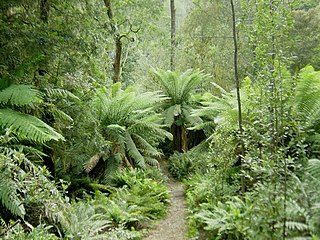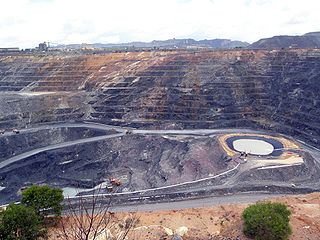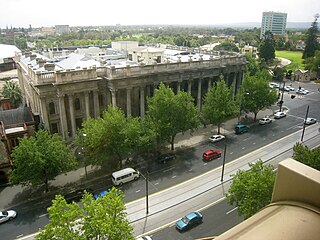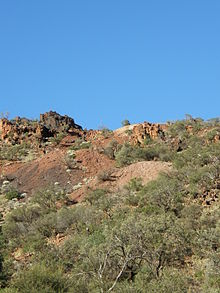
Protected areas of South Australia consists of protected areas located within South Australia and its immediate onshore waters and which are managed by South Australian Government agencies. As of March 2018, South Australia contains 359 separate protected areas declared under the National Parks and Wildlife Act 1972, the Crown Land Management Act 2009 and the Wilderness Protection Act 1992 which have a total land area of 211,387.48 km2 (81,617.16 sq mi) or 21.5% of the state's area.

The Flinders Ranges are the largest mountain range in South Australia, which starts about 200 km (125 mi) north of Adelaide. The ranges stretch for over 430 km (265 mi) from Port Pirie to Lake Callabonna.

The Vulkathunha-Gammon Ranges National Park is a protected area in the Flinders Ranges of South Australia, immediately south-west of and adjacent to the Arkaroola Protection Area. They encompass some of the most rugged and spectacular country in South Australia.

Arkaroola is the common name for the Arkaroola Wilderness Sanctuary, a wildlife sanctuary situated on 610 square kilometres of freehold and pastoral lease land in South Australia. It is located 700 kilometres north of the Adelaide city centre in the Northern Flinders Ranges, adjacent to the Vulkathunha-Gammon Ranges National Park and the Mawson Plateau. The most common way to get there is by car, but air travel can be chartered from Parafield Airport, Adelaide Airport or Aldinga Airfield. It was used as a location set for the 2002 film The Tracker.

The West Coast Range is a mountain range located in the West Coast region of Tasmania, Australia.

The Tarkine, officially takayna / Tarkine, is an area containing the Savage River National Park in the north west Tasmania, Australia, which contains significant areas of wilderness. The Tarkine is noted for its beauty and natural values, containing the largest area of Gondwanan cool-temperate rainforest in Australia, as well as for its prominence in Tasmania's early mining history. The area's high concentration of Aboriginal sites has led to it being described by the Australian Heritage Council as "one of the world's great archaeological regions".

The yellow-footed rock-wallaby, formerly known as the ring-tailed rock-wallaby, is a member of the macropod family.
The Gawler Craton covers approximately 440,000 square kilometres of central South Australia. Its Precambrian crystalline basement crustal block was cratonised ca. 1550–1450 Ma. Prior to 1550 Ma the craton comprised a number of active Proterozoic orogenic belts extending back in time to at least 2450 Ma.
Reginald Claude Sprigg, was an Australian geologist and conservationist. At 17 he became the youngest Fellow of the Royal Society of South Australia. During 1946, in the Ediacara Hills, South Australia he discovered the Ediacara biota, an assemblage of some of the most ancient animal fossils known. He was involved with oceanographic research and petroleum exploration by various companies that he initiated. In 1968, he acquired a derelict pastoral lease, Arkaroola, and transformed it into a wildlife sanctuary and wilderness reserve.

Christopher Cleland Schacht is a former Australian politician and member of the South Australian branch of the Australian Labor Party (ALP). He was born in Melbourne and educated at the University of Adelaide and Wattle Park Teachers College.

Yudnamutana is an historic mining valley in the Northern Flinders Ranges, located at Mount Freeling, North West of Arkaroola on the edge of the wilderness sanctuary. It is accessible by four-wheel drive from the south. Ancient mining sites give the opportunity for ecologically responsible bush camping, but no supplies are available. Walks across the crests of the mountains deliver splendid views over the Flinders Ranges into the plains of the outback. The northern pass hosts black rocks of magnetite.
Paladin Energy Ltd is a Western Australian based uranium production company.
Uranium mining in New Mexico was a significant industry from the early 1950s until the early 1980s. Although New Mexico has the second largest identified uranium ore reserves of any state in the United States, no uranium ore has been mined in New Mexico since 1998.

The Beverley Mine is Australia's third uranium mine and Australia's first operating in-situ recovery mine. It is located in South Australia in the gazetted locality of Wooltana about 35 km from Lake Frome at the northern end of the Flinders Ranges. It officially opened in 2001. The original Beverley uranium deposit was discovered by one of Bill Siller's companies in 1969 and was named after his wife—Beverley Siller.

Radioactive ores were first extracted in South Australia at Radium Hill in 1906 and Mount Painter in 1911. 2,000 tons of ore were treated to recover radium for medical use. Several hundred kilograms of uranium were also produced for use in ceramic glazes.
Mauritania's mineral sector was dominated by iron ore mining and beneficiation. Other mineral commodities produced in the country included cement, copper, gold, gypsum, petroleum, salt, and steel. The Ministère des Mines et de l’Industrie was the Government agency responsible for enacting the Mining Code and for the coordination of all activities in the mining sector. The Direction des Mines et de la Géologie was the entity responsible for promoting the mineral sector and for providing geologic and mining information to potential investors; the Direction des Hydrocarbures was in charge of the development of the petroleum sector; and the Office Mauritanien des Recherches Géologiques was the Government entity responsible for evaluating areas of mineral potential for exploration. Société Nationale Industrielle et Minière (SNIM) was responsible for iron ore production and benefciation.

Namibia has one of the richest uranium mineral reserves in the world. There are currently 2 large operating mines in the Erongo Region and various exploration projects planned to advanve to production in the next few years.
The Agnew Lake Mine was a uranium mine located in the township of Hyman approximately 10 kilometres (6.2 mi) northeast of Agnew Lake, Ontario and 75 kilometres (47 mi) east of Elliot Lake, Ontario.
Arkaroola Protection Area is a protected area located about 600 km (370 mi) north of the Adelaide city centre in the Australian state of South Australia. It was established in 2012 by the Arkaroola Protection Act 2012 "to provide for the proper management and care of the area; and to prohibit mining activities in the area". The protection area is reported as satisfying the definition of a "category II National Park".

Lobbying in South Australia is a growing activity, by which organizations or individuals attempt to influence the Government of South Australia in its policy, regulation and law-making. Since 1 December 2009, lobbyists commercially operating on behalf of third party interests are required to join a register and must also comply with a Code of Conduct. The register is available to the public via the website of the Department of the Premier and Cabinet, and lists the names of registered entities, their employed lobbyists and their clients. As of April 2015, sixty-five different entities are listed on the register, with notable examples including Bespoke Approach and Barker Wentworth.
















